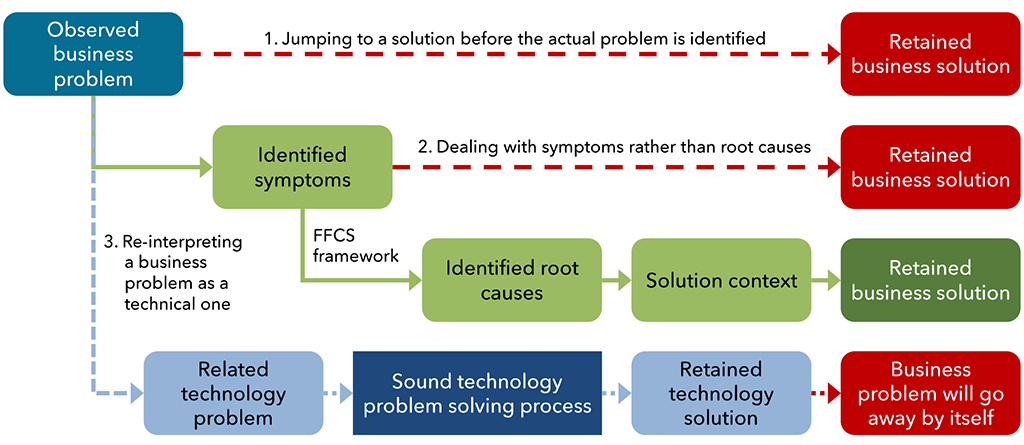Success in business is tightly related to solving everyday business problems efficiently and effectively. Unfortunately, managers often fail because they are unable to identify and solve the right problems. In this insight, I describe a simple framework to address the root causes of these failures. Approaching problem solving through, 1) framing, 2) formulating, 3) contextualizing, and 4) solving provides a proven approach leading to success.
Identifying and solving business problems is at the heart of the everyday activities of any senior manager and executive. Therefore, one would think that managers and executives are good at identifying and solving business problems. Unfortunately, experience shows that this is not the case. Most failures identified can be explained by one of the following three issues or a combination thereof.
ISSUE 1 – JMPING TO A SOLUTION BEFORE THE ACTUAL PROBLEM HAS BEEN IDENTIFIED
Consider a manager confronted with poor sales figures. He over-eagerly concludes that his sales force must be insufficiently qualified. Therefore, additional sales training is deemed necessary. But maybe the real problem is that the product or service to be sold does not offer any perceived value to the targeted customers. Or that the wrong customer segment is targeted in the first place.
ISSUE 2 – DEALING WITH SYMPTOMS RATHER THAN ROOT CAUSES
Consider the observation that the number of failed transaction settlements has increased significantly during the recent market turmoil. An in-depth analysis of the processes performed shows that most mistakes occur during system entry by middle-office employees. As a consequence, an additional control process is introduced, each entered transaction requiring validation by a second employee. But maybe the real problem is that the used software is cumbersome in supporting the data entry processes of the middle-office employees, which leads to a natural percentage of errors.
ISSUE 3 – RE-INTERPRETING A BUSINESS PROBLEM AS A TECHNOLOGY PROBLEM
Consider the head of the investment management division being concerned with the poor investment performance. Analysis shows that risks which materialized were beyond what was expected. From this, he concludes that the efficiency of risk management system used is insufficient and orders the implementation of a new and different state-of-the-art risk management software. But maybe the problem was that investment decision taken were not in line with the investment product’s value proposition and the used risk management software consistently translated them into poor performing portfolio positions.
Exhibit 1 illustrates the three observed, but flawed, approaches to problem solving. In the first approach, managers believe they have seen it all in the past and therefore no analysis is necessary. But if that were so, why was there a problem in the first place.
More thorough managers start by analyzing the problem and identify symptoms that lead to it. But they fail to distinguish between symptoms and root causes.
In the third approach, which is more common that one may think, managers rephrase a business problem as a technology problem. This is very common with managers having a technical background. But also, non-technical managers resort to this approach in order to blame the tech-guy. The problem with this approach is that the assumption of the business problem going away if the technical problem is solved is in most of the cases flawed.

Problem formulation profoundly determines what problem is solved, how it is solved, and ultimately the quality of the solution.
A SIMPLE FRAMEWORK
Based on a paper by Baer, Dirks, & Nickerson, called “Microfoundations of Strategic Problem Formulation”, published in the Strategic Management Journal in 2012, I have developed a simple four step framework, called the FFCS (Framing – Formulating – Contextualizing – Solving) framework, which helps ensuring that the right problem is solved.
- Framing – Conceptualize the problem by identifying all its symptoms through asking questions, rephrasing, and identifying patterns.
- Formulating – Identify the root causes associated with the identified symptoms without discussing possible solutions.
- Contextualizing – Define the constraints and requirements a solution must meet to be implementable. Set realistic boundaries.
- Solving – Develop possible solutions to the formulated problem, focusing on quality rather than quantity. Play with possible solutions, question them, debate them, and reject the ones that do not work or are not viable.
The proposed framework splits the problem-solving activity into four distinct steps.
The framing step focuses on identifying all symptoms and empirical regularities correlated with symptoms. A web of symptoms is the outcome.
During the formulating phases, potential root causes are derived from the symptoms web, structured and prioritized. A fishbone diagram helps in structuring.
Before entering solution discovery mode, the context in which the problem should be solved is defined by answering questions like What are implementation constraints? What requirements must be met? What comprises a valid solution? or Who should be involved in the solving process?
Finally, solutions, addressing the identified root causes, are developed, discussed, questioned, validated, selected, and eventually implemented.
LESSONS LEARNED
- The proposed framework, executed in a team environment, allows analyzing the problem from different angles. It supports the compilation of heterogeneous information and cognitive structures.
- Through separating the identification of symptoms from the problem-solving phase through a root cause analysis, the framework increases the probability that the real problem is solved.
- The contextualizing phase ensures that ideas and possible solutions are only as brilliant as can be implemented. Unrealistic optimal solutions are discarded, and preference is given to sub-optimal but viable ones.
